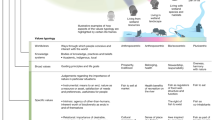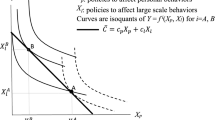Abstract
Biodiversity is acknowledged as one of the most important resources that helps to sustain life’s processes. Additionally, it is also one of the most important sources of livelihood for different kinds of stakeholders at various levels of resource markets—local, domestic, or international. With globalization and increasing sophistication in the methods of commercial trade in biological resources, various issues arise related to the sustenance of resources, of ecological balances, and equity in transactions. All of these are concerns to be addressed to achieve a state of ‘sustainability.’ This paper prescribes to the definition of ‘sustainability’ as the capacity to maintain a certain process or state for “improving the quality of human life while living within the carrying capacity of supporting eco-systems” (IUCN/UNEP/WWF, in Caring for the Earth: a strategy for sustainable living. Gland, Switzerland, 1991). This goes beyond ensuring inter- and intragenerational equity in access to resources and includes several other parameters, including equity among stakeholders to returns from biological resources, related knowledge, trade-offs, and ethical business practices related to these resources. Through the prism of an examination of a simplistic supply route(s) and value addition chain of biodiversity resources for commercial use, this paper reviews and highlights issues related to ‘sustainability’ at each stage. Evidence points to shortcomings in the sustainable use of biological resources at each stage of value addition, calling for focused and specific measures to address them.



Similar content being viewed by others
Notes
For more information, please see ftp://ftp.fao.org/ag/cgrfa/cgrfa11/r11i10e.pdf, last visited 23 February 2009.
Bioproducts refers to products that, essentially, are developed from genetic resources but have undergone various degrees of value addition.
Rainforest Alliance, http://www.rainforest-alliance.org/marketplace.cfm?id=main last visited 20 February 2009.
http://www.fsc.org/about-fsc.html last visited 23 April 2009.
http://www.msc.org/about-us last visited 23 April 2009.
http://www.fairtrade.org.uk/what_is_fairtrade/default.aspx last visited 23 April 2009.
References
Brundtland Commission (1987) Our common future. Oxford University Press, Oxford
Capra F, Pauli G (eds) (1995) Steering business toward sustainability. UNU Press, Tokyo
Convention on Biological Diversity (1992) Text of the convention on biological diversity. Available online at: http://www.cbd.int/convention/convention.shtml. Accessed 20 February 2009
Djoghlaf A (2008) Climate change and biodiversity or the unprecedented planetary environmental challenge facing mankind. Statement at the G8 Dialogue Series convened by the Institute of Advanced Studies of the United Nations University (UNU-IAS), UNU Headquarters, Tokyo, 16 June 2008
FAO (2005) The state of food and agriculture 2005. Agricultural trade and poverty. Can trade work for the poor? FAO Agriculture Series (SOFA)-36
FAO (2006) FAO statistical yearbook, vol 2/2. FAO, Rome
FAO (2007) Updated information provided by the International Centre for Tropical Agriculture (CIAT), regarding its request for a re-examination of U.S. patent no. 5,894,079, CGRFA-11/07/Inf.1. Available online at: ftp://ftp.fao.org/ag/cgrfa/cgrfa11/r11i10e.pdf. Accessed 23 February 2009
Fitzherbert EB, Struebig MJ, Morel A, Danielsen F, Brühl CA, Donald PF, Phalan B (2008) How will oil palm expansion affect biodiversity? Trends Ecol Evol 23(10):538–545
IUCN/UNEP/WWF (1991) Caring for the Earth: a strategy for sustainable living. Gland, Switzerland. IUCN—The World Conservation Union, UNEP—United Nations Environment Programme, WWF—World Wide Fund for Nature
Kaplinsky R, Morris M (2001) A handbook for value chain research. International Development Research Centre (IDRC), Canada
Mcdonald RI, Kareiva P, Forman RTT (2008) The implications of current and future urbanization for global protected areas and biodiversity conservation. Biol Conserv 141(6):1695–1703. doi:10.1016/j.biocon.2008.04.025
McGown J (2006) Out of Africa: mysteries of access and benefit sharing. Edmonds Institute and African Centre for Biosafety, Washington
Millennium Ecosystem Assessment (2005) Ecosystems and human well-being: biodiversity synthesis. World Resources Institute, Washington, DC
Mulliken T (2000) Sustainable use of medicinal plants: a multisectoral challenge and opportunity. In: FAO/ECE/ILO Committee on Forest Technology, Management and Training, 2003, Seminar Proceedings on Harvesting of Non-Wood Forest Products. International Agro-Hydrology Research and Training Center in Menemen-Izmir, Turkey, 2–8 October 2003
Olsen CS, Helles F (1997) Medicinal plants, markets, and margins in the Nepal Himalaya: trouble in paradise. Mountain Res Develop 17(4):363–374
Olsen CS, Larsen HO (2003) Alpine medicinal plant trade and Himalayan mountain livelihood strategies. Geograph J 169(3):243–254. http://www.jstor.org/stable/3451450. Accessed 23 February 2009
Ricketts T, Imhoff M (2003) Biodiversity, urban areas, and agriculture: locating priority ecoregions for conservation. Conserv Ecol 8(2):1. http://www.consecol.org/vol8/iss2/art1/. Accessed 20 February 2009
Sachs J (2006) Does conservation matter to the poor? Nat Conserv Mag. http://www.nature.org/magazine/summer2006/features/art17768.html
Suneetha MS (2004) Economic valuation of medicinal plants in the context of the convention on biodiversity and IPR regulations. Unpublished PhD thesis, University of Agricultural Sciences, Bangalore
Suneetha MS, Chandrakanth MG (2002) Trade in medicinal plants in Kerala—issues, problems and prospects. J Med Aromatic Plant Sci 24:756–761
Suneetha MS, Chandrakanth MG (2006) Establishing a multi-stakeholder value index in medicinal plants—an economic study on selected plants in Kerala and Tamilnadu States of India. Ecol Econ 60(1):36–48. doi:10.1016/j.ecolecon.2006.02.010
Suneetha MS, Pisupati B (2009) Benefit sharing in ABS: options and elaborations. UNU IAS Report, UNU-IAS
Swinton SM (2004) Too poor to be stewards? Rural poverty and sustainable natural resource management. Department of Agricultural, Food, and Resource Economics, Staff Paper Series #2004-06, Michigan State University. http://purl.umn.edu/11694. Accessed 23 April 2009
Syngenta (2006) Corporate Social Responsibility Report, Syngenta
Tallec F, Bockel L (2005) Commodity chain analysis. Constructing the commodity chain functional analysis and flow charts. EASYPol, on-line resource materials for policy marking, Module 043. FAO. Available online at: http://www.fao.org/docs/up/easypol/330/cca_043EN.pdf. Accessed 23 April 2009
ten Kate K, Laird SA (1999) The commercial use of biodiversity: access to genetic resources and benefit-sharing. Earthscan Publications Ltd., London
URBIS (2008) The Urban Biosphere Network. Home page at: http://www.stockholmresilience.su.se/research/researchthemes/urbansocialecologicalsystems/urbis.4.87749a811cbd4c4fb4800027930.html. Accessed 23 April 2009
Zhao S, Peng C, Jiang H, Tian D, Lei X, Zhou X (2006) Land use change in Asia and the ecological consequences. Ecol Res 21:890–896. doi:10.1007/s11284-006-0048-2
Author information
Authors and Affiliations
Corresponding author
Additional information
Edited by Mitsuru Osaki and Ademola Braimoh, Hokkaido University, Japan.
Rights and permissions
About this article
Cite this article
Suneetha, M.S. Sustainability issues for biodiversity business. Sustain Sci 5, 79–87 (2010). https://doi.org/10.1007/s11625-009-0098-9
Received:
Accepted:
Published:
Issue Date:
DOI: https://doi.org/10.1007/s11625-009-0098-9




